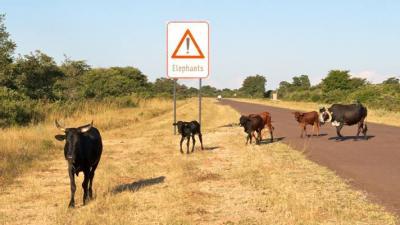Some groups insist that eating meat is bad for the environment. They even invented a bogus metric, it takes a gallon of gas to make a pound of beef, to show the environmental harm of not being a vegetarian.
Wildlife groups have a different agenda - balancing nature in diversity hotspots with a better life for people living there and instead of looking at ways to ban meat, they looked at ways to make meat safer. A new paper by the Wildlife Conservation Society (WCS), World Wildlife Fund (WWF) and regional partners finds that a new approach to beef production in southern Africa could positively transform livelihoods for farmers and pastoralists, while helping to maintain a future for wildlife and wildlife-based tourism opportunities. In Namibia, beef production accounts for 87% of gross agricultural income and is a mainstay of the economy.
Market access for livestock and livestock products from Africa is constrained by the presence of foot and mouth disease (FMD). Fear of the FMD virus largely precludes large-scale beef exports from Africa to potentially lucrative overseas markets and hinders trade within Africa itself. Wild buffalo, an ecologically and economically critical species in the region, can transmit the FMD virus to livestock but are not themselves affected.
The study looked at new commodity-based (value chain) approaches to beef trade (commodity-based trade or CBT) that focus on the safety of the process by which products are produced rather than on whether a given cow was raised in a location where wildlife like buffalo also roam. This food safety-type approach offers the potential for export of meat products that are scientifically demonstrable as safe from animal diseases for importing countries, while also diminishing the need for at least some of the veterinary fencing currently aimed at separating livestock and wildlife and constraining the Southern African Development Community's vision for regional trans-boundary wildlife conservation, which has in some places begun to surpass livestock agriculture in terms of its contribution to regional GDP through tourism and related industries. O
Economist Dr. Jonathan Barnes led a comprehensive cost-benefit analysis evaluating policy options related to animal disease management and land-use decisions in Caprivi, Namibia. Caprivi is a core part of the Kavango Zambezi ("KAZA") transfrontier conservation area (TFCA) that is home to extraordinary wildlife including the largest population of elephants in the world (approximately 250,000). KAZA includes contiguous portions of Angola, Botswana, Namibia, Zambia and Zimbabwe, and may become the largest terrestrial area available to migratory wildlife on the planet if FMD-related land-use conflicts can be resolved.
Caprivi was selected for study in part because it is currently classified as an FMD-infected zone as its livestock and wildlife populations have co-existed for many years and cattle is important in Namibia. The study found that economic costs associated with development of CBT in Caprivi would be outweighed by economic gains in terms of enhanced wildlife-based income generation, abattoir viability, and livestock-based incomes. Further, income growth is more diversified when CBT is applied, therefore less risky. CBT, because of its emphasis on science-based approaches to ensure that the meat produced is free of dangerous pathogens, helps assure product safety regardless of whether wildlife like buffalo also live in the area of livestock origin and therefore makes more conventional approaches that rely on fences to physically separate livestock and wildlife less necessary.

An elephant crossing in Caprivi, Namibia? No, these are cattle. Namibia thrives on cattle, it is the cultural currency in marriage and divorce and young girls are told to walk slowly, 'like a cow'. Credit: © Dr. Mark Atkinson, WCS AHEAD.
In contrast, the analysis showed that a scenario using spatially segregated, fenced FMD-free livestock compartments is technically impractical and would be economically undesirable. Here, significant loss of growth in wildlife-based incomes, and significant costs for fencing and maintenance, would outweigh any new economic gains in abattoir viability and / or livestock farming incomes.
"By carefully looking at the economics of different land-use planning options, it appears the way to optimize economic development in this case is through a value-chain approach to beef production," said Dr. Jon Barnes. "This would open up new markets for southern African farmers and reduce the threat to key wildlife movements brought about by fencing-based approaches to disease management."
The authors believe that the findings have important implications for development policy in and around the KAZA TFCA, and possibly other TFCAs in southern Africa. They strongly suggest that initiatives aimed at introduction of CBT to underpin sanitary risk management offer significant economic potential. At the same time, this approach can assist in meeting other TFCA objectives, such as the restoration of diverse ecosystems by re-opening corridors that allow for wildlife movements across large, historically connected landscapes. This will provide greater resilience in the face of natural catastrophes, disease outbreaks and /or climatic challenges.
"By working proactively to improve the health and productivity of animals and people, recognizing up front that livestock and wildlife depend on a much more unified approach to land-use management, we believe we're onto what had been an elusive but highly prized 'win-win' solution to the age-old problem of getting beef out of areas where wildlife is also allowed to thrive– a win for wildlife as well as for communities who have long relied on domestic animals both economically and culturally," said Dr. Steve Osofsky, Director of the WCS AHEAD program.





Comments